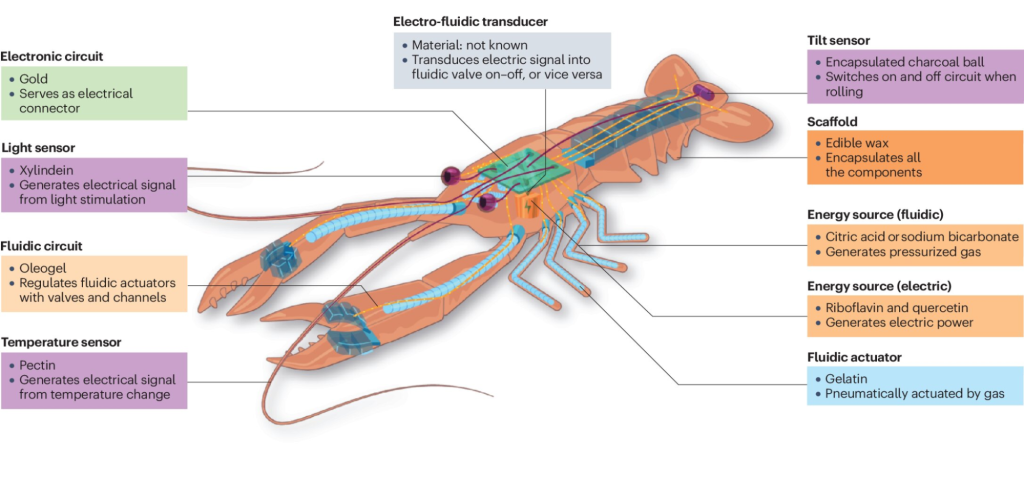NEWS
Other News
- Byte-Sized Bots: How Edible Robots Are Cooking Up a Storm in Tech
- Green Dreams on Your Wall: The Terrarium Revolution You Never Knew You Needed
- This Smart Bird Feeder Is Revolutionizing Backyard Birdwatching
- Meow-raculous Breakthrough: The Cat Food That's Making Allergies Vanish
- Nature Meets Academia: The Mind-Blowing University Building That's Rewriting the Rules
- The Wearable That Predicts Your Pee: Dfree's Ultrasound Bladder Sensor
- LG's See-Through OLED TV Turns Sci-Fi Dreams into Reality
- This Ultimate Health Gadget Puts a Doctor in Your Pocket
- This AI-Powered Mirror Wants to Boost Your Mood
- Work, Workout, and Charge Your Phone: The Office Bike That Does It All
- Meet WIM, the AI-Powered Robot That's Revolutionizing How We Walk
- Ever Heard of an Inflatable Farm? Well, Meet AirFarm!
Byte-Sized Bots: How Edible Robots Are Cooking Up a Storm in Tech

We’re living in wild times, folks. Just when you thought technology couldn’t get any crazier, scientists are now cooking up robots you can actually eat. That’s right – edible robots are on the menu, and they might be showing up on your plate sooner than you think.
A team of brilliant minds from the École Polytechnique Fédérale de Lausanne (EPFL) in Switzerland is leading the charge with their aptly named “RoboFood” project. These researchers have joined forces with colleagues from Wageningen University, the University of Bristol, and the Italian Institute of Technology to make this sci-fi concept a reality.
But why on earth would anyone want to eat a robot? Well, it turns out there are some pretty compelling reasons. These edible machines could help tackle electronic waste, deliver vital nutrients and medications to people and animals in need, and even monitor our health from the inside out. And for the foodies out there, they might just revolutionize the way we experience food altogether.
So, are you ready to sink your teeth into the future of robotics? Let’s dig in and see what’s cooking in the world of edible robots.
Artistic representation of a futuristic edible robot. Credit: Nature Reviews Materials (2024). DOI: 10.1038/s41578-024-00688-9
What's on the Menu?
You might be wondering what exactly goes into making a robot you can chow down on. The RoboFood team has been hard at work figuring out which edible ingredients can stand in for traditional robot parts. And some of their solutions are downright ingenious.
Imagine a robot with muscles made of gelatin, a skeleton of rice cookies, and a protective chocolate coating to keep it safe from moisture. Sound tasty? These scientists are even working on edible glue by mixing starch and tannin.
But building an entire edible robot is no piece of cake (pun intended). The researchers are still trying to find edible materials that can mimic the properties of their non-edible counterparts. It’s a delicate balance between functionality and flavor.
We’re living in wild times, folks. Just when you thought technology couldn’t get any crazier, scientists are now cooking up robots you can actually eat. That’s right – edible robots are on the menu, and they might be showing up on your plate sooner than you think.
Building Blocks of Edible Bots
The RoboFood team isn’t starting from scratch. They’re building on some impressive advances in edible robotics that have already been made. Let’s take a look at some of the coolest components they’ve cooked up so far:
Back in 2017, EPFL scientists created an edible gripper made entirely of gelatin. This nifty little device could pick up an apple and then be eaten afterward. Talk about a handy snack!
Researchers from EPFL, IIT, and the University of Bristol have developed a conductive ink that can be sprayed right onto food. This ink uses activated carbon as a conductor and – get this – Haribo gummy bears as a binder. It can sense things like pH levels, light, and even bending.
In 2023, IIT researchers unveiled the world's first rechargeable edible battery. It uses riboflavin (vitamin B2) and quercetin (found in almonds and capers) for the battery poles, with activated carbon to help electrons move around. They even wrapped it in nori seaweed to prevent short circuits. This little powerhouse can run at a safe 0.65 volts, and two of them together can light up an LED for about 10 minutes.
Pretty impressive stuff, right? But we’re still a ways off from a fully functional, completely edible robot.
Chewing on the Challenges
Creating a robot you can eat isn’t all smooth sailing. There are some serious hurdles the RoboFood team needs to overcome before we’ll be seeing edible androids on store shelves.
For starters, edible materials just aren’t as durable or versatile as traditional robot components. They’re softer, more fragile, and a lot more susceptible to environmental factors like humidity and temperature. Imagine trying to build a precise, high-functioning machine out of ingredients you’d find in your pantry – not exactly a walk in the park.
Then there’s the power problem. While that edible battery is a huge step forward, it’s still not nearly powerful enough to run a complex robot for any significant amount of time. And let’s not forget about processing power – creating an edible microchip that can handle the calculations needed for a functioning robot is a whole other can of worms.
Safety is another big concern. How do we ensure that these edible robots are actually safe to consume? What happens if they malfunction inside the body? These are questions that will need solid answers before edible robots can become a reality.
The Potential Payoff
Despite the challenges, the potential benefits of edible robots are pretty mind-blowing. Let’s break down some of the ways these futuristic munchies could change the game:
By creating robots that can be safely consumed or biodegraded, we could significantly cut down on electronic waste. No more worrying about how to dispose of that old smartphone – just eat it!
Imagine swallowing a tiny robot that could navigate your digestive system and deliver medication exactly where it's needed. This could revolutionize treatments for all sorts of conditions.
Edible robots could act as internal health monitors, tracking vital signs and alerting doctors to potential problems before they become serious.
These robots could potentially help with sustainable farming practices or even be used as a food source themselves in emergency situations.
For the adventurous eaters out there, edible robots could open up a whole new world of gastronomic experiences. Dinner and a show, anyone?
When Can We Expect Edible Robots?
So, when will you be able to order a robot off the menu at your local restaurant? Well, don’t hold your breath just yet. While the RoboFood project is making impressive strides, we’re still a long way from fully functional edible robots.
The technology is in its infancy, and there are still many technical, safety, and ethical hurdles to overcome. But the pace of innovation in this field is rapid, and breakthroughs are happening all the time.
It’s hard to put an exact timeline on when we might see the first commercially available edible robot. But given the potential benefits and the intense interest from researchers around the world, it’s not unreasonable to think we might see some form of edible robotic technology hit the market within the next decade or two.
Food for Thought
The concept of edible robots is undeniably exciting, but it also raises some interesting questions. Are we ready for a world where the line between food and technology is blurred? How will this impact our relationship with both our devices and our meals?
There are also ethical considerations to ponder. Could edible robots be used in ways that are harmful or exploitative? How do we ensure they’re developed and used responsibly?
These are big questions without easy answers. But they’re worth thinking about as we move into this brave new world of edible technology.
The Potential Payoff
Edible robots might sound like something out of a science fiction novel, but thanks to the hard work of researchers like those on the RoboFood team, they’re inching closer to reality every day. While we’re still a ways off from chomping down on a fully functional android, the progress being made is nothing short of remarkable.
From gelatin grippers to vitamin-powered batteries, the building blocks of edible robotics are already here. And as the technology continues to advance, who knows what incredible innovations we’ll see next?
So the next time you sit down for a meal, take a moment to appreciate your food. Because someday, that plate of pasta might just get up and walk itself right into your mouth. The future of robotics is looking mighty tasty indeed.


